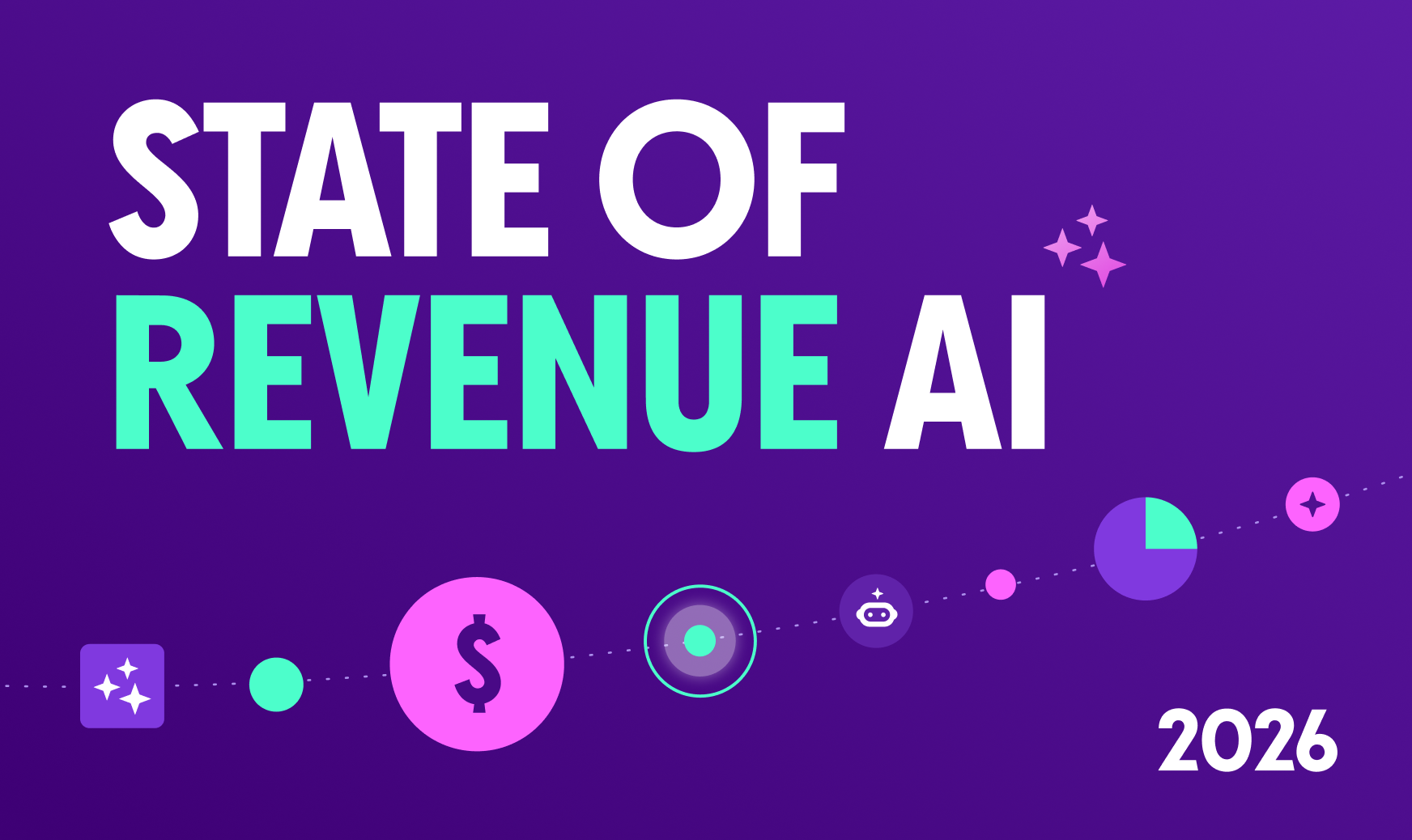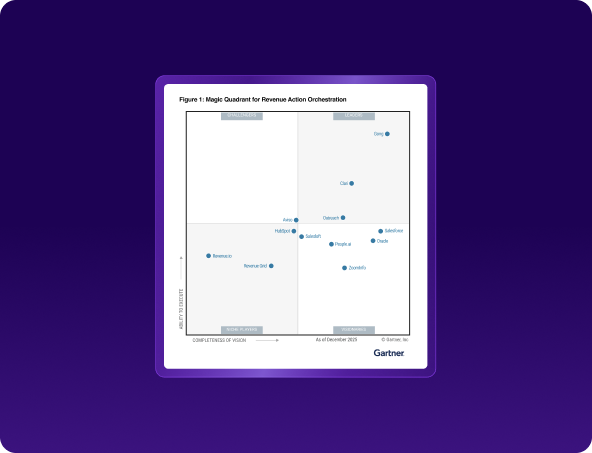Sales strategies
Designing a strategic sales plan: a blueprint for success

Dan Morgese
Director, Content Strategy and Research at Gong
Published on: June 5, 2025
Having a strategic sales plan isvital. It sets out everything your sales team needs to know about your sales process, including what they need to do at every stage of the B2B sales funnel to convert high-value leads.
In other words, a strategic sales plan helps your sales reps avoid firing aimlessly into the market and missing more often than they hit.
This article will examine what a strategic sales plan entails, why teams struggle without one, and how to build a successful plan of your own.
What is a strategic sales plan?
A strategic sales plan is a detailed strategy that outlines how to target and sell to potential customers. It lays out a clear path to reaching your sales goals.
Strategic sales focus on selling relationships or using a consultative approach . That means understanding a prospect’s pain points and personalizing your pitch to highlight how your product solves those pains.
A strategic sales plan is a lot of work, but it shouldn’t just cover who you’ll target or what outreach tactics your reps will use. It should coverevery stage of the sales process .
Why is a strategic sales plan essential?
A strategic sales plan is essential for targeting high-value, enterprise clients for several reasons:
Improves sales performance and increases revenue
In McKinsey’s Future of B2B Sales report, 50 percent of sales leaders said their reps don’t have the capabilities they need to succeed. To reach revenue goals, reps need to boost their skills with training, clear direction, and up-to-date materials.
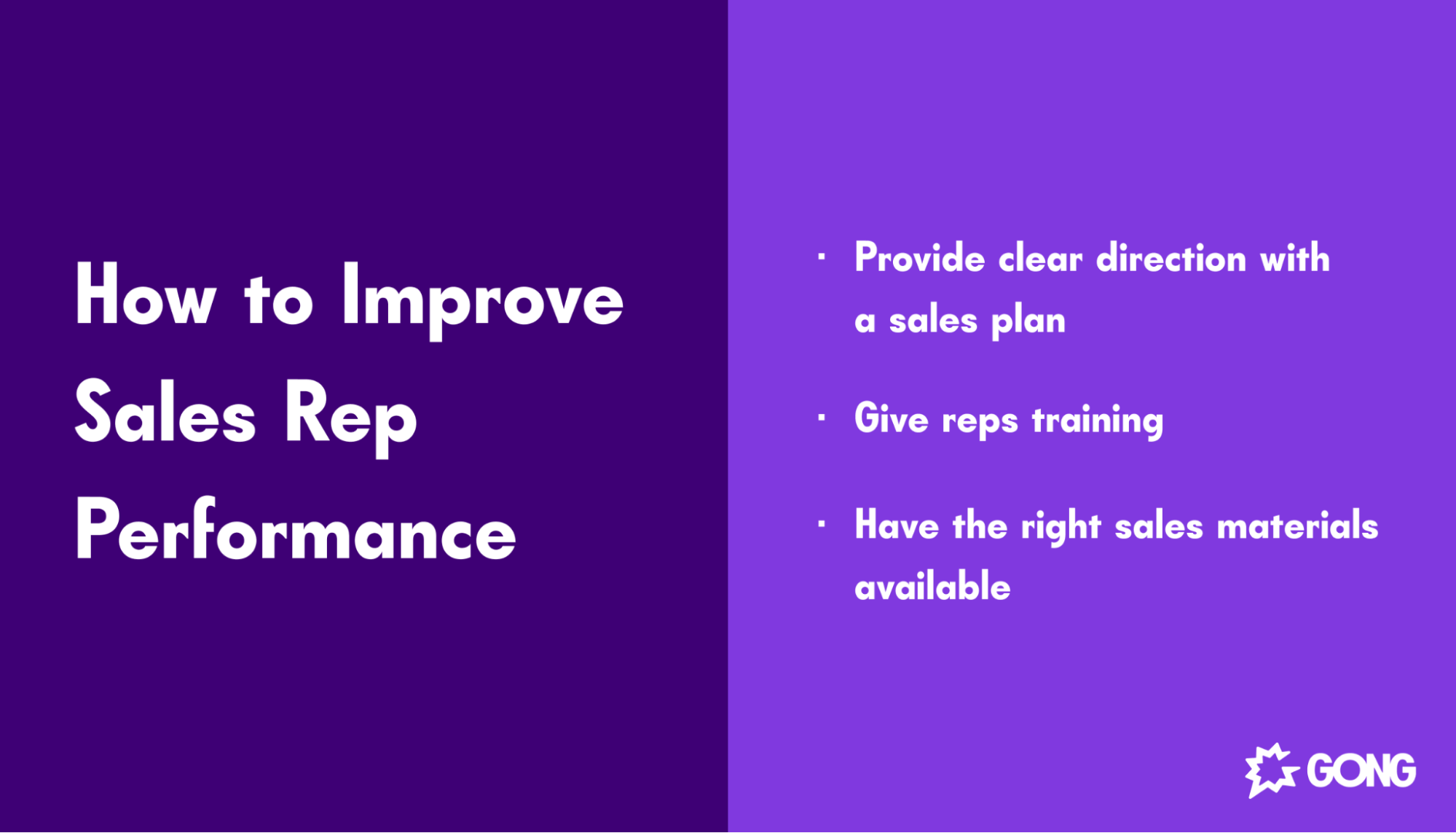
A strategic sales plan helps make the pathway to wins clearer and more straightforward. It shows reps exactly:
- Who they should target
- What to do at each pipeline stage
- Which materials and product data they need to finalize deals
Creates strong buyer relationships
When your reps are crystal clear on their sales strategy, they work efficiently and have more time to spend with potential buyers. This extra time and attention does wonders for buyer-seller relationships.
A strategic sales plan gives buyers the experience they want. Since 83 percent of buyers initiate first contact, it’s up to sales representatives to respond with the appropriate tone and build rapport.
A clear sales plan and readily available resources give reps the confidence they need to build trust with buyers and win new business.
Targets and closes high-value clients
You can’t close enterprise accounts with transactional sales tactics. As shown below, enterprise deals are high-value and highly complex:
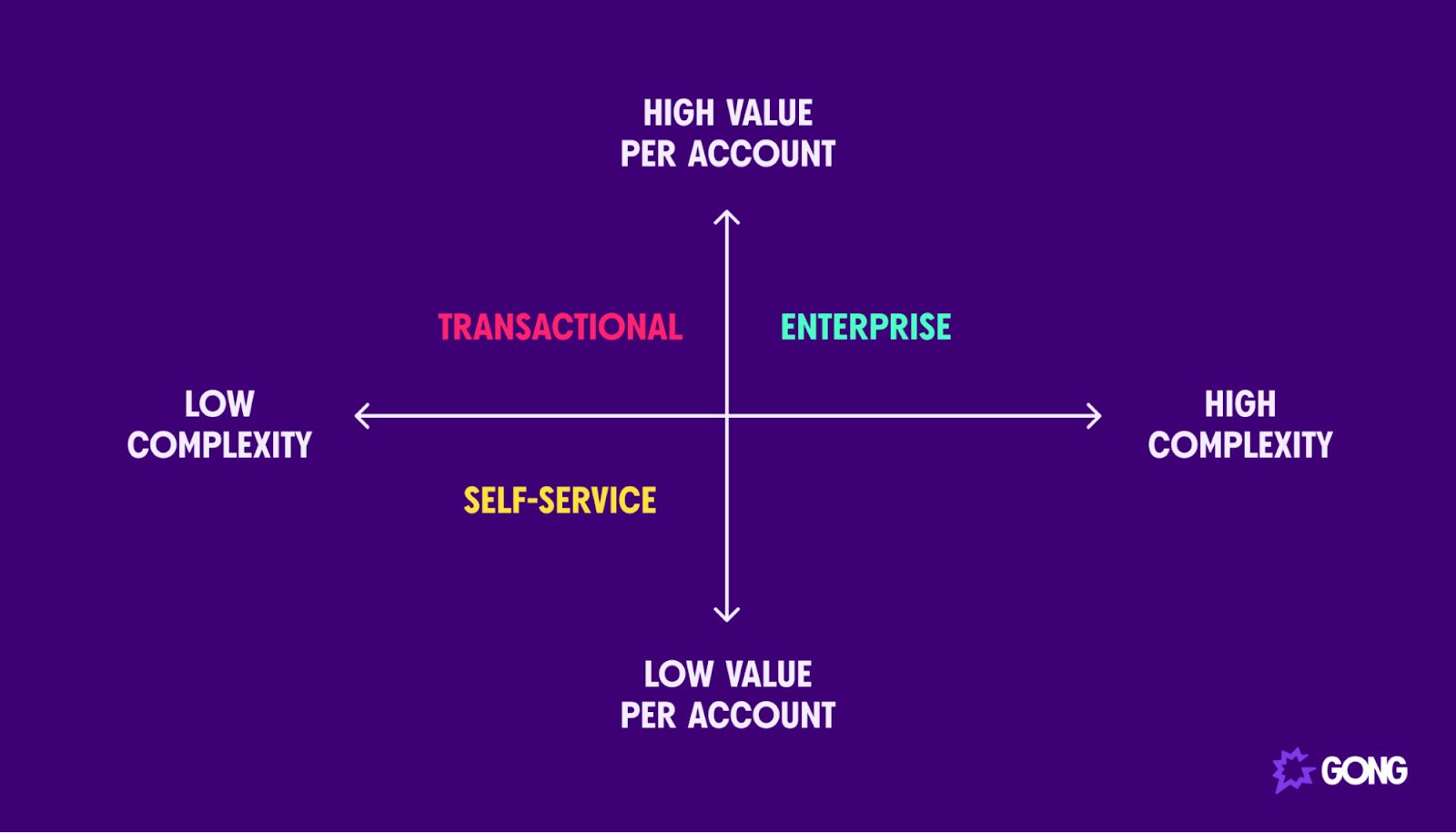
These deals require a well-defined and well-executed sales strategy. It should help reps identify who to target, arm them with an effective sales methodology, and outline the best next steps.
When should you implement a strategic sales plan?
You should implement a strategic sales plan when you need to:
- Reach sales goals consistently
- Launch a new product
- Increase revenue
Let’s take a closer look at each one.
Reach sales goals consistently
Sales and revenue are bound to fluctuate. But if you regularly miss your targets, it could be due to the lack of a proper sales plan. Without one, your team doesn’t know where to focus their efforts, which leads to missed opportunities.
A strategic sales plan lays out clear goals, timelines, and which steps to take at each pipeline stage so reps can achieve their targets. It specifies:
- What to prioritize
- How to allocate time and resources
- Which customer segments to target
- How to move prospects through the sales funnel
When reps are set up for success, they’re more likely to hit monthly, quarterly, and annual quotas and contribute to a more predictable revenue stream.
Launch a new product
To launch a new product or service, you need a marketing and sales plan to help make it as smooth and successful as possible. Sales planning plays a critical role in crafting a go-to-market strategy, guiding teams through every step of the process.
Here are the most common elements your sales plan should touch on for GTM initiatives:
- Who:Clearly define your target customers — their needs, pain points, and desires.
- What:Outline your product or service’s unique features and benefits.
- Why:Establish your brand positioning by asking yourself, “Why should someone choose my offer over a competitor’s offer?”
- Where:Identify the platforms your ideal clients use so you can reach them easily.
- How:Strategize how you’ll promote the product and which sales tactics you’ll use.
- When:Determine the best time to launch based on market conditions and client readiness.
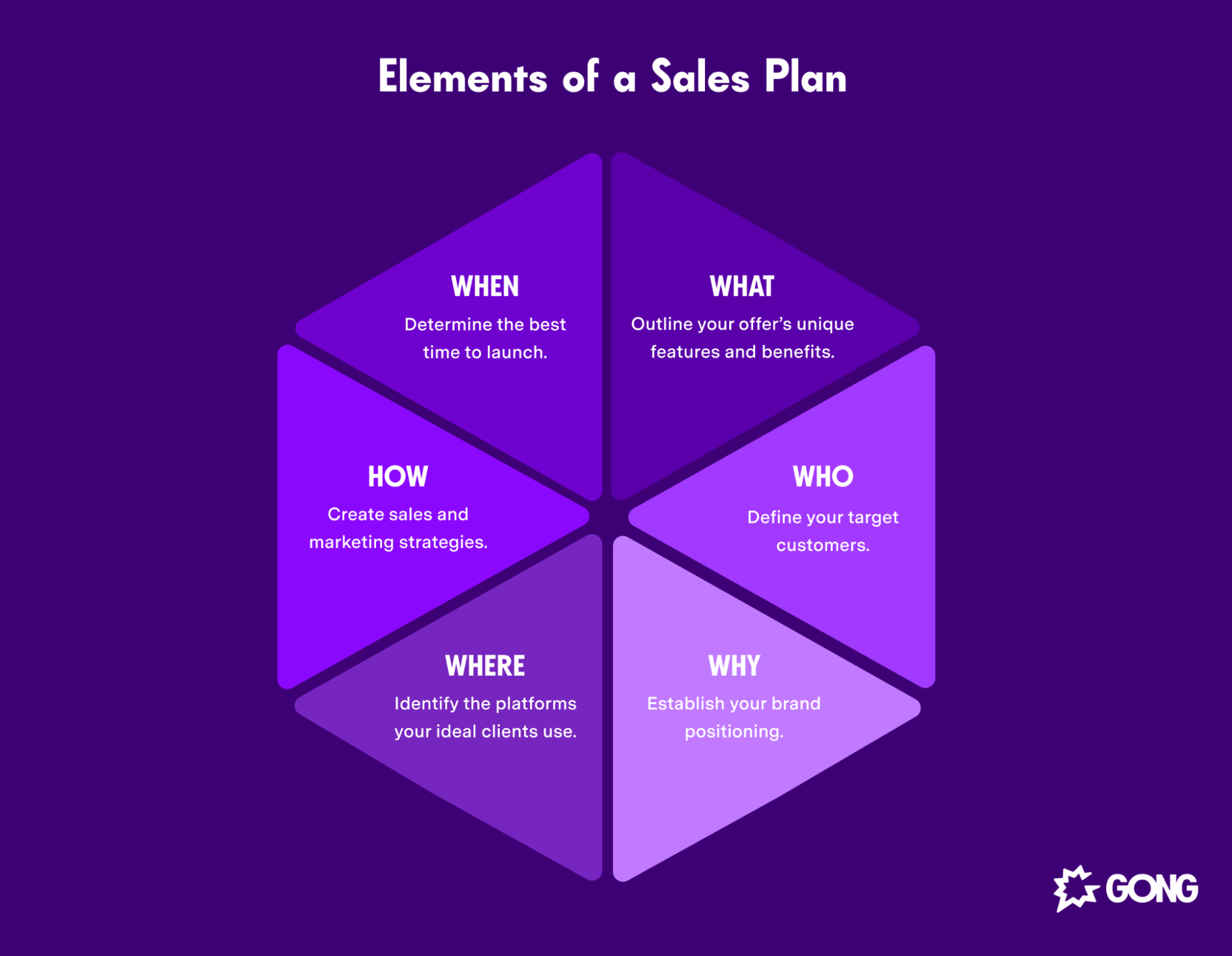
By fine-tuning these elements and then training accordingly, your sales and marketing teams will be fully prepared for the launch and know what to do at every step in the process.
Increase revenue
One of the best ways to achieve a quick revenue boost is to leverage your existing client base. This can be done through cross-selling, upselling, or referrals.
- Cross-selling:Offer additional products or services to an existing client, making sure it complements their previous purchases.
- Upselling:Recommend an upgraded or premium version to existing customers. For example, someone with a basic software subscription might benefit from a premium plan with more features and hands-on support.
- Referrals:Encourage existing clients to recommend your offers to people they know.
Incorporate these strategies into your sales plan so your reps know the process for cross-selling and upselling buyers. Focusing on clients they already have relationships with makes this easier and leads to quicker conversions (and boosts your bottom line).
How to create a high-impact strategic sales plan
Make sure your strategic sales plan covers everything it should by following the six steps below:
1. Set goals
The first thing you need to do when creating a strategic sales plan is set at least one realistic and achievable goal. Otherwise, your reps will be left to their own devices. Everything else you do going forward will relate to the goal(s) you set at this stage, so spend time getting this step right.
The most effective sales goals will align with your company’s broader objectives. If you’re about to enter a new market or launch a new product, take this into consideration as you set your sales goals.
In some cases, executives will set your goals for you. They might require that your team hit a specific revenue target or increase market .
Whoever sets them, make sure goals follow the SMART framework:
- Specific
- Measurable
- Attainable
- Relevant
- Time-based
When setting goals, consider historical data and current trends to help ensure they’re attainable.
For instance, look back over previous quarters in your CRM to gauge past performance, and then check your latest forecast to factor in current market conditions.
When you set your sales goals, also set quotas for your reps. Remember that not everyone will achieve their targets.
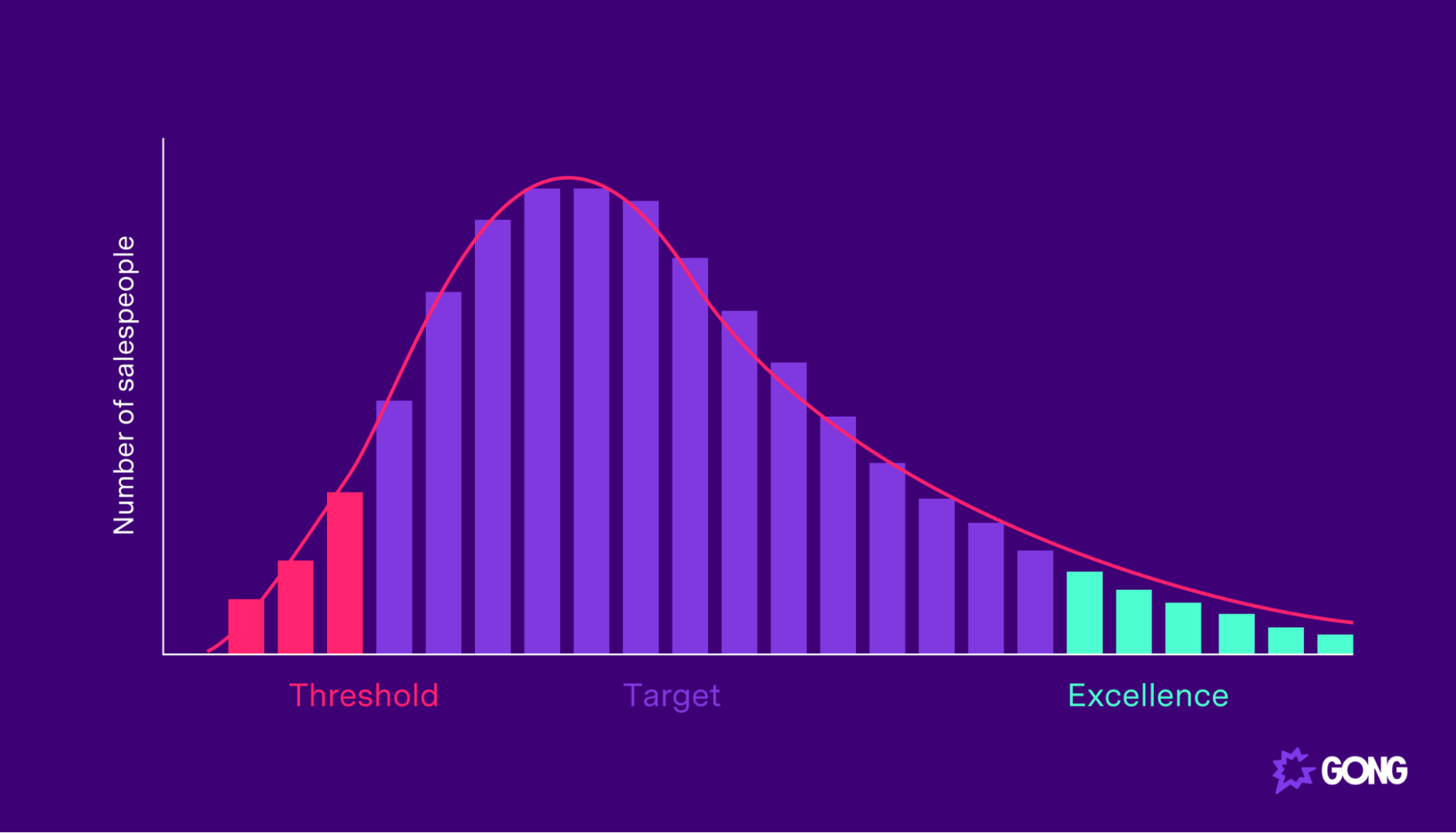
A surprising 40 percent of reps fail to hit their targets. As shown above, most sales reps will fall somewhere in the middle, just about hitting their targets.
With this in mind, try to strike a balance between pushing your sales team and setting achievable quotas. If, after six months, your reps’ success looks like the graph above or better, you’re on the right track.
Clearly, accurate data is essential to setting realistic and achievable revenue goals for your sales team.
2. Outline your ideal buyer
The next part of a strategic sales plan is knowing who to target. The more clearly you define your ideal customer profiles (ICP) and buyer personas, the more easily your reps can target and personalize their approach.
An ICP is a detailed description of your best accounts’ firmographic, behavioral, and environmental qualities. It includes information like their industry, location, revenue, and headcount.
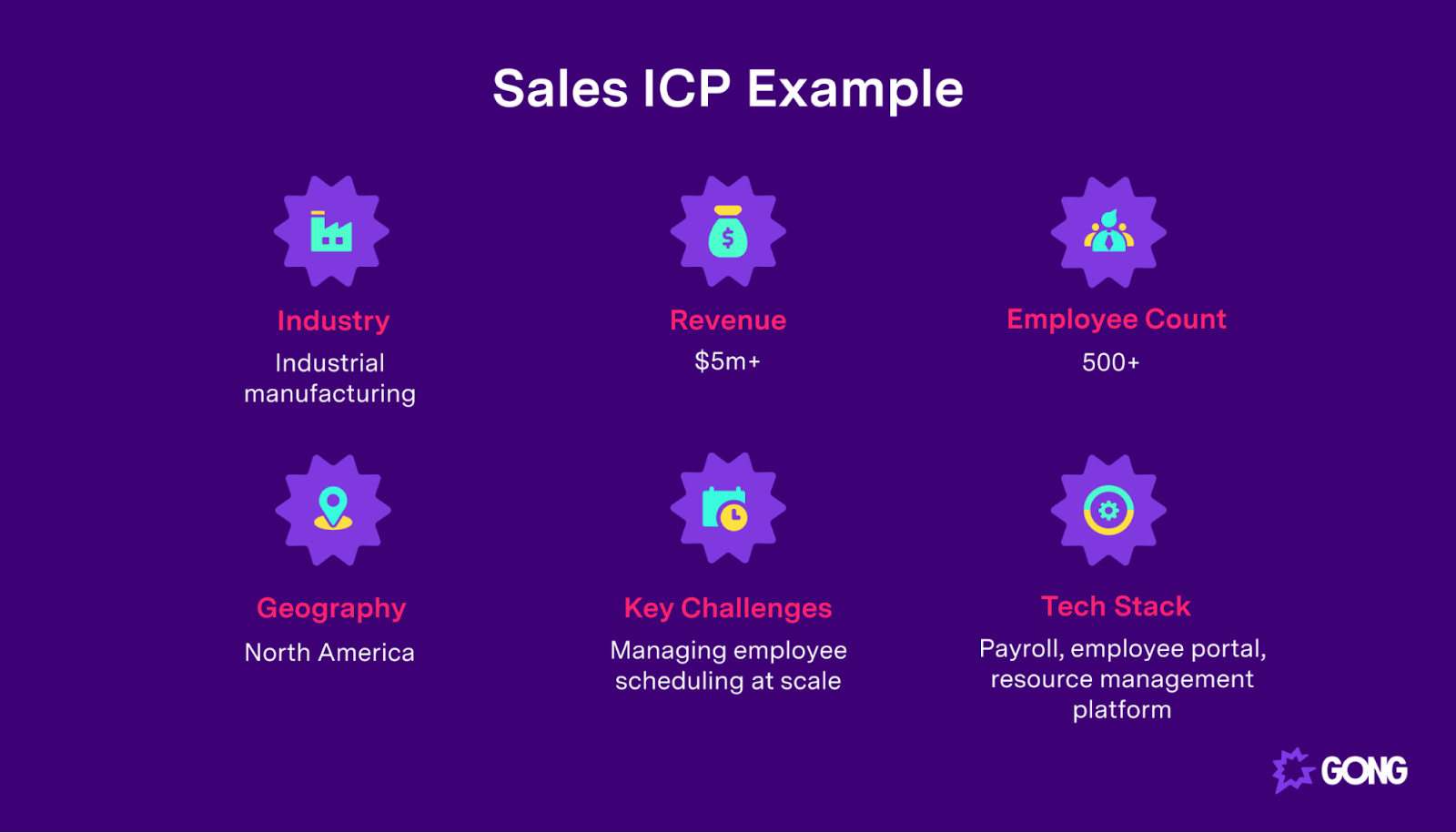
A buyer persona describes the decision-makers at your target companies. It explains who they are, what they do, their pain points, goals, and challenges.
To supercharge a strategic sales strategy, focus on accounts with the same characteristics as your best buyers. How? Make your ICPs and personas data-backed with details from your CRM and other sales tools.
Once you identify and document your ideal buyer profile, focus your team’s efforts only on accounts that match those criteria.
A strategic sales plan takes a long-term approach to relationship-building and converting deals, so reps don’t waste time on companies that were never a good fit in the first place.
3. Choose a relevant sales methodology
Your sales methodology is the framework your sales team uses to close accounts. All effective sales strategies need a clear sales methodology to guide their selling process.
When building a strategic sales plan, choose a methodology that positions your sales reps as advisors to your target buyers.
Here are a few methodologies worth considering:
- Challenger selling educates buyers about the solution and challenges what they believe to be true.
- Sandler selling builds relationships with buyers and advises them on overcoming their pain points.
- SPIN selling examines the situation, problem, implication, and need for a payoff to help the buyer see that they need your solution.
Any of these consultative approaches can lay the foundation you need to win high-value accounts.
4. Define your sales process
A sales process is a set of repeatable steps your sales reps must complete during each sales cycle. Map out these steps in detail as part of your strategic sales plan.
There are a couple of reasons you should do this. First, it’ll ensure that your reps follow a repeatable process whenever they speak to a buyer. Second, it’ll help you analyze and optimize your sales processes by identifying bottlenecks so you can eliminate them.
What’s more, your sales process should line up with your sales pipeline and your sales funnel .
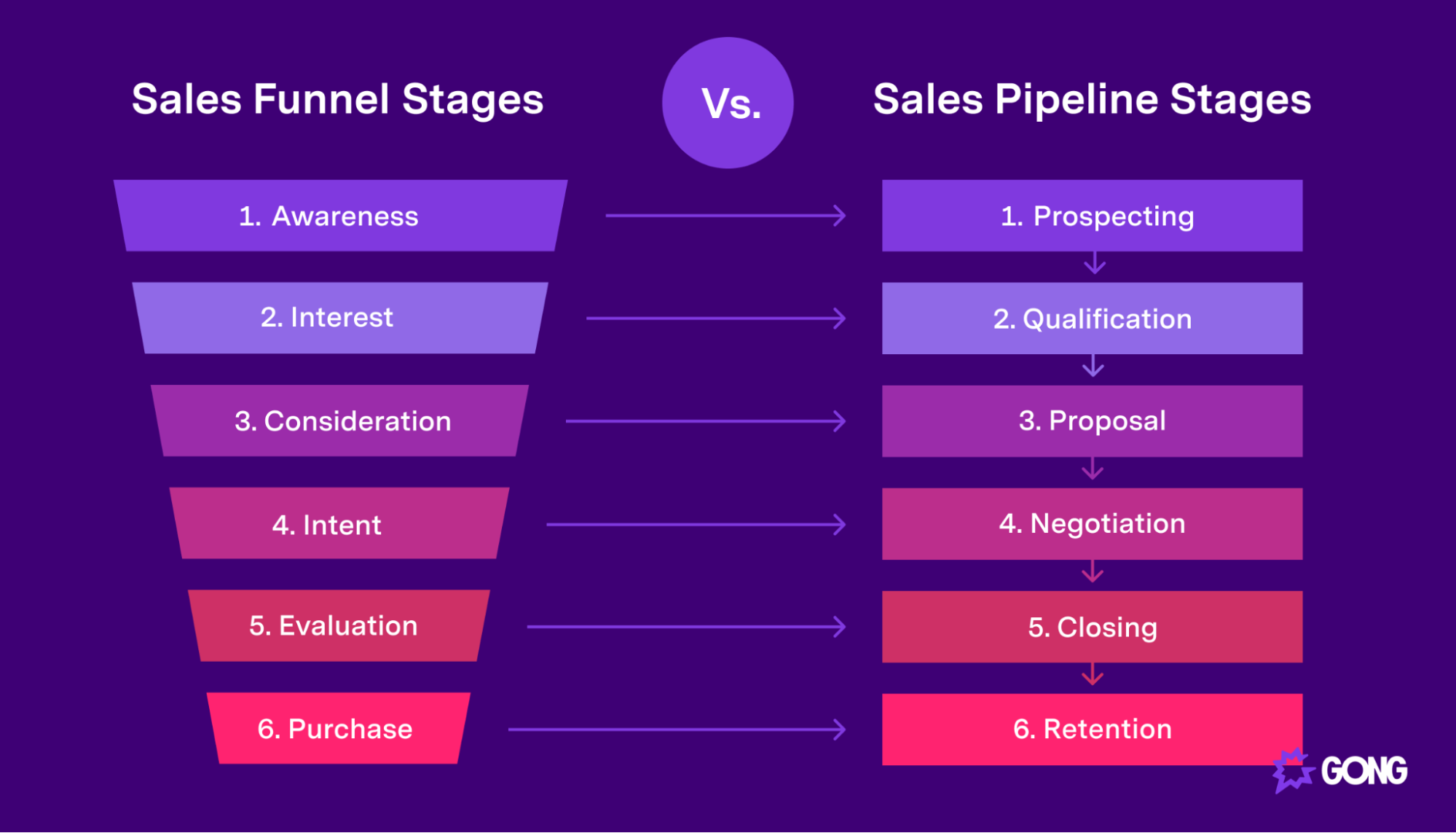
As you can see, the stages match reasonably well between the pipeline and the funnel. Prospecting matches the awareness stage. Closing matches the evaluation stage, and so on.
A sales process gives you much-needed visibility into your pipeline and allows you to track metrics at every stage. This not only keeps your sales reps focused throughout the buying process but also helps you monitor and optimize your strategic sales plan.
If applicable, you should designate roles for your sales reps at this stage. For instance, some sales managers prefer to divide labor by letting junior reps prospect and book meetings while more experienced reps negotiate and close deals.
5. Equip your team with sales enablement collateral
Sales materials need to be available to reps when they need them. If not, they’ll likely struggle to close deals. Even the best salespeople can’t sell a product they don’t know what to send a buyer and when.
Your strategic sales plan should include all the sales collateral and resources sales reps will need, such as:
Don’t just compile them in a folder and forget about them.
Incorporate them into your onboarding process for new reps. Additionally, ensure that best practice demonstrations are available as needed should reps need advice on how to use battle cards or present a case study.
At this point, you should also draw up a training process so that any new reps you hire can quickly learn your sales methodology and processes.
Ensure your team understands your product or service clearly, and on an ongoing basis. Your collateral should never be static; it’s evergreen and ever-changing.
Tools are also essential.
With a Revenue AI Platform like Gong , sales reps get AI-powered insightson the next best steps to take. Gong Assist can automate and streamline those processes to boost business efficiency.
6. Measure your success
Even the best-made sales strategy plans need to be optimized and improved on an ongoing basis. That’s why the final part of your sales strategy should cover how to track and evaluate your team’s success.
Measuring and tracking the right KPIs is crucial. Start by monitoring these metrics:
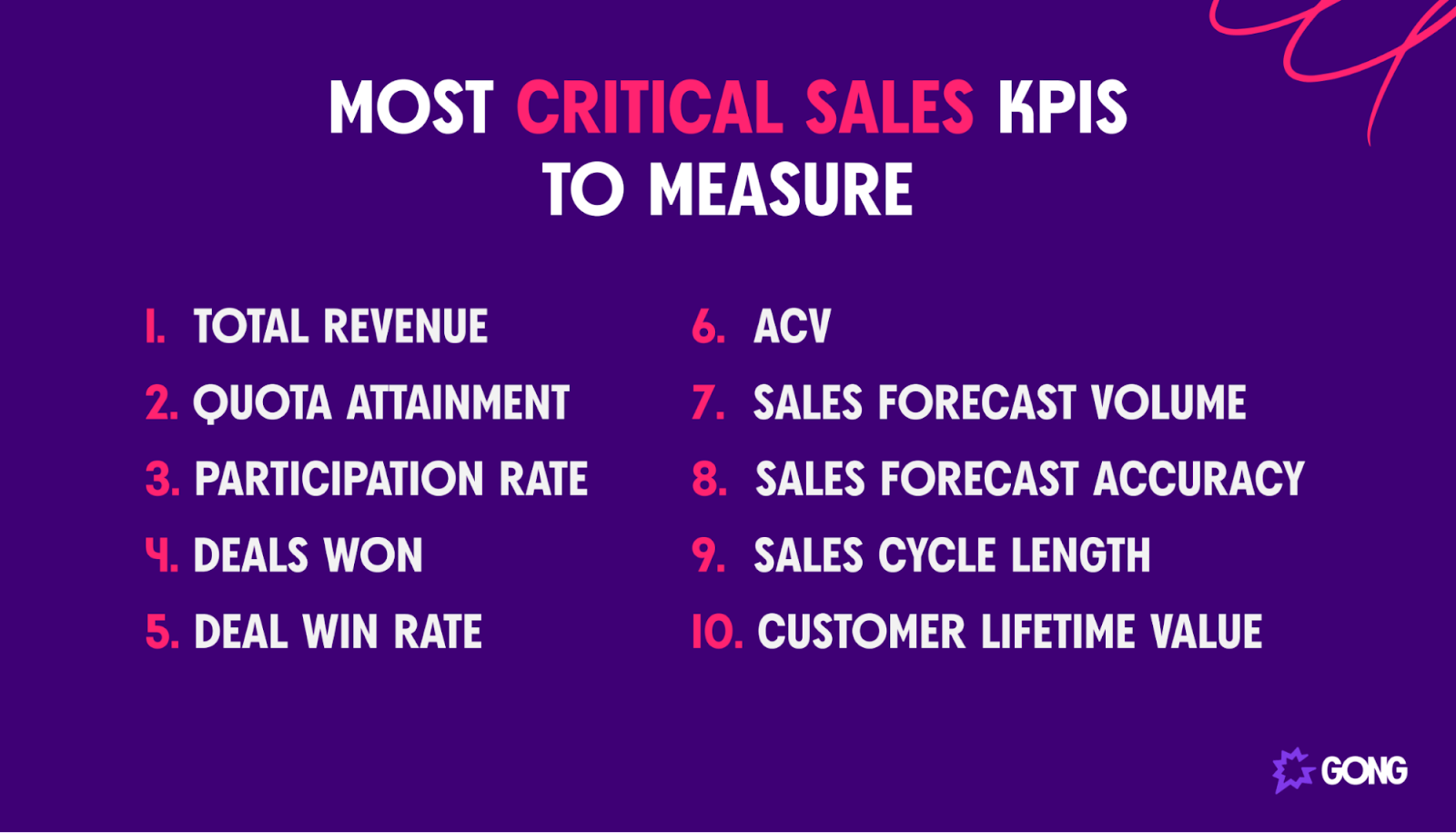
Capture those metrics in automated reports you can with your team and higher-ups. Accurate, impactful reporting can also help you improve your strategic sales plan (by refining ICPs, for example) and set more attainable goals (by improving forecast accuracy ).
That’s only possible if you analyze your reports and take action. Schedule regular meetings with your team and senior stakeholders. Review your progress and look for ways to optimize your sales process and overarching strategy.
5 most common types of sales plans
Here are the most common types of sales plans (some with templates). Use them individually or combine them to create a solid plan your team can follow.
1. Comprehensive sales plan
This is the most common type of sales plan. It includes your entire sales process and all the information your marketing and sales teams need. It’s a highly detailed plan with a complete list of your target audience, competitors, objectives, budget, and more.
This type of sales plan provides the ultimate clarity and ensures that everyone is on the same page. It’s beneficial for businesses looking to refine or scale their operations.
So, if you struggle to hit targets and your reps always ask the same questions, this plan could help. Zapier has a free Sales Plan template that you can use.
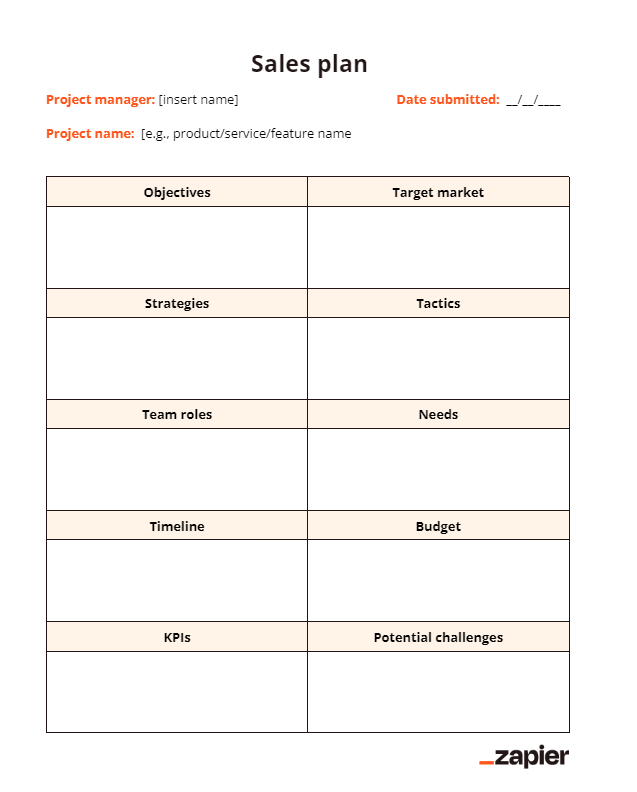
2. Marketing alignment sales plan
A marketing alignment plan helps you bridge the gap between your marketing and sales teams. Misalignment between these two departments can lead to confusion, wasted resources, and lost opportunities.
This type of plan ensures that departments work together to reach the same objectives and provide consistent messaging across communication channels for potential clients.
The plan typically includes KPIs, customer personas, and campaign timelines to ensure that marketing efforts succeed in finding qualified leads that the sales team can convert into buyers.
3. 30-60-90-day sales plan
This three-month sales plan can be used to train new reps or sell in new territories. It breaks down activities into different phases:
- Phase one (first 30 days):In this phase, reps get to know the company, clients, offers, and internal processes.
- Phase two (next 30 days):In this phase, reps should begin implementing the knowledge they gained by starting to sell, fine tuning messaging, and testing initial sales strategies.
- Phase three (final 30 days):At this point, reps must be fully operational, work independently, and hit sales targets.
You can use Yesware’s free 30-60-90 Day Sales Plan Checklist to create yours.

4. Product launch plan
This plan can ensure that your teams are aligned to create an effective go-to-market strategy. The plan should include:
- Detailed timelines for launching
- Product or service pricing
- Market analysis and positioning strategy
- Client targeting (messaging and platforms)
- Promotional strategy (ads, social media, or content marketing)
You can use Atlassian’s Product Launch Plan template to design and execute your launch for better success.
5. Market expansion plan
The market expansion plan helps you enter new territories — nationally or internationally. It helps you identify new customer segments and regions that could benefit from your offers.
This plan should include market research, a competitive analysis, projections, and marketing strategies to help you establish your brand in a new market.
This plan is ideal if you don’t want to take unnecessary risks. It helps mitigate the risks of entering new territories and provides a roadmap for growth in unfamiliar markets.
Make Gong a part of your strategic sales plan
A Revenue AI Platform is pivotal as you plan, execute, and oversee your strategic sales plan.
With an AI-powered solution like Gong, you can easily monitor your team’s pipeline, spot at-risk deals, forecast more accurately, and see if you’re on track to hit your monthly, quarterly, and annual targets.
Get started with Gong today , or download our high-growth sales plan template to create yours.
This content was original published on in December 2022 by Jonathan Costet. It was edited and updated for clarity, recency, and relevanceby Dan Morgese in June 2025.

Director, Content Strategy and Research at Gong
For over a decade, Dan has provided revenue leaders with data and insights to inform and execute their GTM strategies. As a former analyst at Forrester Research, he worked with hundreds of B2B organizations to measure and improve sales productivity.
Discover more from Gong
Check out the latest product information, executive insights, and selling tips and tricks, all on the Gong blog.
